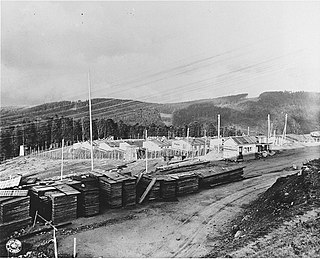
Natzweiler-Struthof was a Nazi concentration camp located in the Vosges Mountains close to the villages of Natzweiler and Struthof in the Gau Baden-Alsace of Germany, on territory annexed from France on a de facto basis in 1940. It operated from 21 May 1941 to September 1944, and was the only concentration camp established by the Germans in the territory of pre-war France. The camp was located in a heavily forested and isolated area at an elevation of 800 metres (2,600 ft).

Herta Bothe was a German concentration camp guard during World War II. She was imprisoned for war crimes after the defeat of Nazi Germany, and was subsequently released early from prison on 22 December 1951.

Judenfrei and judenrein are terms of Nazi origin to designate an area that has been "cleansed" of Jews during The Holocaust. While judenfrei refers merely to "freeing" an area of all of its Jewish inhabitants, the term judenrein has the even stronger connotation that any trace of Jewish blood had been removed as an alleged impurity in the minds of the criminal perpetrators. These terms of racial discrimination and racial abuse are intrinsic to Nazi anti-Semitism and were used by the Nazis in Germany before World War II and in occupied countries such as Poland in 1939. Judenfrei describes the local Jewish population having been removed from a town, region, or country by forced evacuation during the Holocaust, though many Jews were hidden by local people. Removal methods included forced re-housing in Nazi ghettos especially in eastern Europe, and forced removal or Resettlement to the East by German troops, often to their deaths. Most Jews were identified from late 1941 by the yellow badge as a result of pressure from Joseph Goebbels and Heinrich Himmler.

Behind Enemy Lines is a 2002 autobiographical book co-written by Holocaust survivor Marthe Cohn and Wendy Holden. It details Cohn's exploits as a French Jew during the Holocaust and World War II when, working as a nurse, she traveled into German territory to collect intelligence for the French Army, as the Allied forces started making advances on Germany, pushing the German forces back during World War II

Numerous internment camps and concentration camps were located in France before, during and after World War II. Beside the camps created during World War I to intern German, Austrian and Ottoman civilian prisoners, the Third Republic (1871–1940) opened various internment camps for the Spanish refugees fleeing the Spanish Civil War (1936–1939). Following the prohibition of the French Communist Party (PCF) by the government of Édouard Daladier, they were used to detain communist political prisoners. The Third Republic also interned German anti-Nazis.

Laure Diebold, sometimes written Laure Diebolt was a high-profile female member of the French Resistance during World War II. She was also the private secretary of Jean Moulin before being arrested then deported from 1943 to 1945 to the Nazi camp of Auschwitz, Ravensbrück and finally Buchenwald. Moreover, she is one of only six female resistants to be awarded the title Compagnon de la Libération.

Hélène Berr was a French Jewish woman, who documented her life in a diary during the time of Nazi occupation of France. In France she is considered to be a "French Anne Frank". She died from typhus during an epidemic of the disease in Bergen-Belsen concentration camp that also killed Anne Frank and her sister Margot.

The history of the Jews in Alsace is one of the oldest in Europe. It was first attested to in 1165 by Benjamin of Tudela, who wrote about a "large number of learned men" in "Astransbourg"; and it is assumed that it dates back to around the year 1000. Although Jewish life in Alsace was often disrupted by outbreaks of pogroms, at least during the Middle Ages, and reined in by harsh restrictions on business and movement, it has had a continuous existence ever since it was first recorded. At its peak, in 1870, the Jewish community of Alsace numbered 35,000 people.

Jeanne-Marie Matthey-Jonais was a French tennis player. She competed during the first two decades of the 20th century. Matthey won the French Open Women's Singles Championship four times in succession from 1909 to 1912, but lost the 1913 final to Marguerite Broquedis.

Germaine Ribière was a French Catholic, member of the Résistance, who saved numerous Jews during World War II, and was recognized as a Righteous Among the Nations.

Marianne Cohn, was a German-born French Resistance fighter.

Line of Demarcation is a 1966 war drama film written and directed by Claude Chabrol. Its title in French is La Ligne de démarcation. It is based on upon the memoir Mémoires d'un agent secret de la France libre et La Ligne de démarcation by Gilbert Renault under his pseudonym Colonel Rémy.
Marthe Mathilde Cnockaert, later Marthe McKenna, was a Belgian nurse who became a spy for the United Kingdom and its allies during the First World War. She later became a novelist, and is credited with writing over a dozen spy novels in addition to her memoirs and short stories.
Alice Cohn (1914–2000) was a German-Jewish graphic artist and master forger for the Dutch resistance during World War II.

Anne-Lise Stern was a French psychoanalyst and Holocaust survivor.

Paulette Weill Oppert Fink (1911–2005) was a French-Jewish nurse and resistance worker during the Second World War. She later emigrated to the United States where she helped to raise money in support of the new State of Israel. An executive member of the National Women's Division of the United Jewish Appeal, she was elected chair in December 1960.
Renee Bornstein, was a French-born Holocaust survivor, who lived in Manchester, England. She was the wife of Ernst Israel Bornstein, a Polish-born Holocaust survivor and author of Die Lange Nacht, a memoir of his experiences during WWII, published in English as The Long Night.

Many priceless artworks by the Dutch Post-Impressionist artist Vincent van Gogh were looted by Nazis during 1933–1945, mostly from Jewish collectors forced into exile or murdered.














